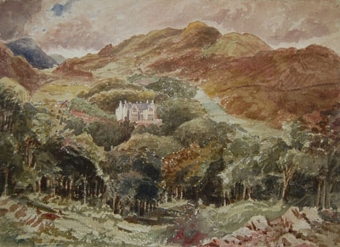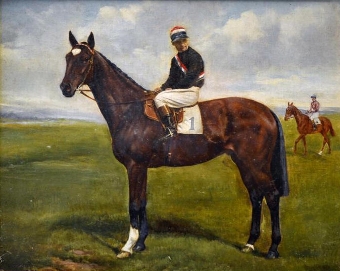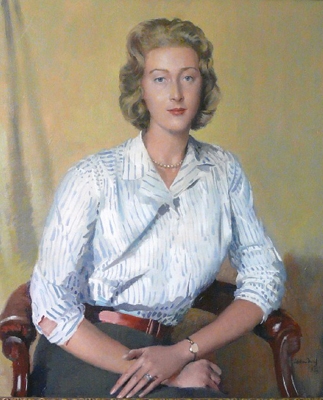portrait of admiral of the fleet , sir george cockburn, 10th bt, 1772-1853
- View other items in:
- antiques interior design modern and vintage
- other interior design
artware ltd
Enquire about this antique
Artware Ltd has 565 antiques for sale.
click here to see them all
The reverse re-lining inscribed "Ambrosini Jerome 1835"
Admiral of the Fleet Sir George Cockburn, 10th Baronet (22 April 1772 ? 19 August 1853) (surname pronounced /''ko?b?rn/, Scottish English: was a British naval commander of the late 18th through the mid-19th centuries. He held important commands during the Napoleonic Wars and the War of 1812 and eventually rose to become Admiral of the Fleet and First Sea Lord.Born in 1772 in London, George was the second son of Sir James Cockburn, 8th Baronet (1729-1804) and his second wife Augusta Anne Ayscough. His maternal grandfather was Francis Ayscough, Dean of Bristol. Cockburn went to sea at the age of 14. He rose rapidly in the Royal Navy, perhaps because his father was a baronet, but most certainly because he was a brave and resourceful officer. He saw much action during the Napoleonic Wars and successfully commanded a succession of sloops, frigates and ships of the line. After serving on the home station, and in the East Indies and the Mediterranean, he assisted, as captain of the Minerve ( at the blockade of Leghorn in 1796, and fought a gallant action with the Spanish frigate Sabina which he took. He was present at the battle of Cape St Vincent. In 1809, in command of the naval force on shore, he contributed greatly to the reduction of Martinique, and signed the capitulation by which that island was handed over to the British; for his services on this occasion he received the thanks of the House of Commons. After service in the Scheldt and at the defence of Cadiz he was sent in 1811 on an unsuccessful mission for the reconciliation of Spain and her American colonies.
By 1812, he was a rear admiral in charge of the squadron of the Royal Navy in Spanish waters, but in that year he was ordered to America. Cockburn played a major role in the War of 1812 as second in command to Admiral Sir John Borlase Warren to the end of March 1814 and then to Warren''s successor, Admiral Sir Alexander Cochrane for the rest of the war. He cruised relentlessly up and down the Chesapeake Bay and other parts of the Atlantic coast in 1813 and 1814, seizing American shipping, disrupting commerce, and raiding the ports. In the Chesapeake, Cockburn was responsible for carrying out government instructions to encourage the emigration of the enslaved Black population. In addition he implemented Cochrane''s own plan of recruiting a Corps of Colonial Marines from among the Black refugees. The most important of Cockburn''s actions was the capture and burning of Washington on 24 August 1814 as an advisor to Major General Robert Ross. He later served as the commander during the British occupation of Cumberland Island and St. Marys, Georgia. The Battle of Fort Peter was the only result of the campaign. Cockburn received the order of the Bath at the beginning of 1815, and after the war, on his return to Europe, he was immediately given the job of conveying Napoleon in the Northumberland to Saint Helena, where he remained for some months as governor of the island and the Emperor''s jailor. In later life, Cockburn was Commander-in-Chief on the North American station, and eventually Admiral of the Fleet. From 1827 he was a Privy Counsellor. He was also elected several times to Parliament as a Tory (for Portsmouth 1818-1820, Weobly 1820-1828, Plymouth 1828-1832 and Ripon 1841-1847)and served several times as First Sea Lord (1828?1830; 1834?1835; 1841?1846). In 1839 he became the first President of the Shipwrecked Fishermen and Mariners'' Royal Benevolent Society. In 1852, he inherited the family baronetcy from his elder brother, being himself succeeded by his brother William, dean of York, who died in 1858. Admiral Cockburn died in 1853 at Leamington Spa, leaving a daughter.
Captain George Cockburn was one of a number of able officers who served under Nelson. Cockburn served in the Mediterranean from 1795 to 1797 and wrote of Nelson, "next to my own father, I know of none whose company I so much wish to be in or who I have such real reason to repsect". It is likely that much of the affection that this shows stemmed from the co-operation with Nelson in the sharing of prize money. Nelson left his squadron at Leghorn in the command of Cockburn whilst he communicated with the Austrian army on shore or to Admiral Jervis. Nelson was happy to leave Cockburn to carry out the tasks of blockading the Italian ports "we so exactly think alike on points of servicc that if your mind tells you it is right, there can hardly be a doubt but I must approve". Nelson lobbied Jervis to appoint Cockburn to a larger command and he was duly rewarded with the 42-gun frigate La Minerve captured from the French. Nelson sailed in La Minerve to oversee the evacuation of Elba in 1796. Near Gibraltar, Commodore Nelson directed a short action in which the Spanish ship Santa Sabina was captured. Nelson and Cockburn sailed from Gibraltar in February 1797, passing through the Spanish fleet at night and in thick fog. Nelson carried the news of the Spanish fleet to Admiral Jervis who was patrolling off Cape St. Vincent before transferring from La Minerve to Captain. Thomas Masterman Hardy served as Lieutenant under George Cockburn. It was as Captain Hardy that he was to become famous as Captain of Victory at Trafalgar (1805). Minerve sailed from Gibraltar on 11th February 1797. That night (11/12 February 1797) saw Minerve sailing in fog. During the morning watch she found herself sailing through dark shapes in the night - which turned out to be the Spanish fleet. Minerve remained unseen by the sleeping Spanish lookouts and Nelson and Minerve passed safely through the Spanish fleet. By daylight, Minerve was again on her own and now Nelson was intent on finding Admiral Jervis with news of the whereabouts of the Spanish. Nelson and Minerve found Jervis on 13th February. Nelson passed the news to Jervis who laid plans for the inevitable battle - the Battle of Cape St. Vincent. George Cockburn rose to become Admiral of the Fleet, Sir George Cockburn. As Rear-Admiral he commanded the detachment of Royal Marines that put Washington to fire during the war of 1812 (the Americans used white paint to hide the fire damage, creating what has become known as ''The White House'') . In 1815, in command of Northumberland he was to transport the defeated Napoleon Bonaparte into exile on the island of St. Helena. He died in 1853.
"Ambrosini" was born on 8th August 1810 and christened James Parker. He went to Italy to study painting for some years and whilst there married a Miss Scarrotti. Later in life he married Mary Hudson, widow of Archdeacon Hudson. "Ambrosini" died in April 1883 in Brecknock Road, Camden Town, near the junction with Hilldrop Road. He won an Academy Gold Medal and was appointed Portrait Painter to the Duchess of Kent. Mr Collins has nine portraits by him mostly of members of the family. In lists of artists and their works, James Parker J?r?me is called Miss Ambrosini J?r?me. Unfortunately, once an error is made, it is copied until it becomes fact! Most of his pictures are signed Ambrosini J?r?me or A. J?r?me as he found an Italian sounding name was better for business in the mid-19th Century.
Antiques.co.uk Ref: 53EEDWDG
- Materials:
- Oil on Canvas
- Width (cm):
- 91.44 x 71.12 cm 36.00 x 28.00 ins
Artware Ltd
Artware Fine Art specialises in fine antique, decorative and historical portraits and topographical pictures . We cover a period from the 17th and 18th centuries through to the 19th & 20th Centuries. We have over 150 portraits in stock, which can be viewed on our web site, each historical portrait has well researched biographical information both on the sitter and the artist.
Contact details
18 La gare
51 Surrey row
London
Greater London
SE1 0BZ
UNITED KINGDOM
T: 0207 921 97904
E: greg@artwarefineart.com
W: www.artwarefineart.com














